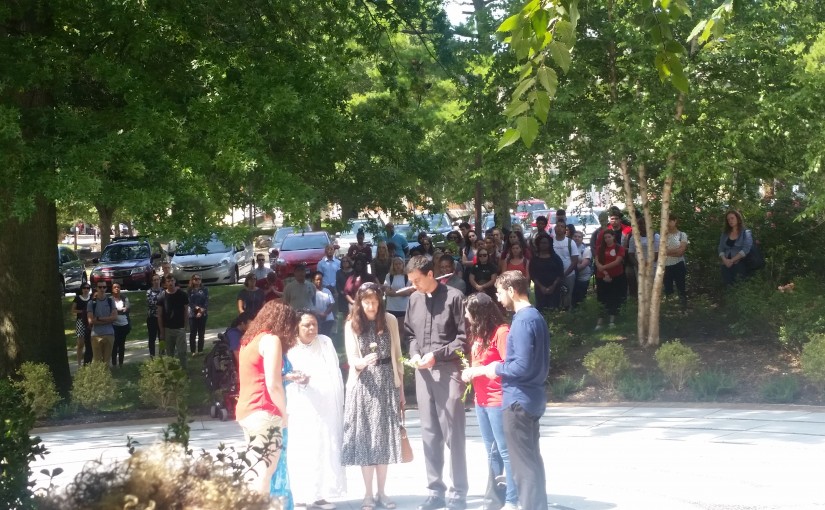At 12:05 on Wednesday afternoon, a crowd gathered at the Montgomery Hall bus stop. The rush of passing cars, the chatter of nearby students and echoes from Route 1 traffic filtered in, but the group spent the next 60 seconds in complete silence.
The crowd of about 25 stood still, some with their heads down, while others faced the back of the small canopy that held a picture of Richard Collins, a black Bowie State University student who was three days shy of graduation when he was fatally stabbed at the bus stop in May.
After the minute ended, a woman looked at the photo as she silently read from a prayer book. A student stood next to her, closing his eyes. She closed the book. He opened his eyes. And slowly, the group dispersed.
The campuswide minute of silence was held in honor of Collins, who was 23 and a newly commissioned second lieutenant in the U.S. Army when he was killed. Former university student Sean Urbanski, who is white, has been indicted on a murder charge. The killing is under investigation as a possible hate crime, although Urbanski, formerly a member of a racist Facebook group called “Alt Reich: Nation,” has not so far been indicted on hate crime charges.
[Read more: “Hatred and tragedy”: Following the homicide of Richard Collins III]
Bowie State and other University System of Maryland campuses simultaneously observed the moment, which was advertised in a text alert, on this university’s ELMS website and on posters hung campuswide.
Event organizer Brooke Lecky Supple, chief of staff for the Office of the Vice President of Student Affairs, called the moment historic.
“We are not aware of any other campuswide moment of silence in multiple locations,” she said. “There have been moments of silence at large events like commencement or basketball games, but never on this scale.”
Stamp Student Union director Marsha Guenzler-Stevens agreed.
“I have been here 35 years and I don’t remember something quite like this,” she said. “We have certainly had moments of silence at large-scale events — including on 9/12, after events on 9/11, but I am not sure of another campus-wide coordinated effort.”
University President Wallace Loh was in the Stamp food court for the minute of silence, watching people pile in to take part in the moment.
“I thought it was a very touching and moving moment,” he said. “It sends a signal that we’re honoring what he stood for — his life — and also that we are committed to improving our diversity, our inclusiveness and our respect for each other.”
At 11 a.m., outside McKeldin Library, the English department encouraged students walking by to write letters of condolence to Collins’ family.
Benny Berhanu, a freshman enrolled in letters and sciences, saw others writing and decided to join in, even though he wasn’t a student at this university when Collins was murdered.
“[I’ll] pray for them,” he said, referring to Collins’ family. “That’s all I can really do.”
In freshman Zaria Stebbins’ landscape and architecture class, Professor Dennis Nola stopped class before 12:05 to speak about Collins.
“He made sure that the people of color in the class felt reassured that the classroom is a safe space and that you’ll always expect him to be fair to you,” she said. “I thought that was really great to see because you don’t really see that often.”
[Read more: Some UMD students call on administration to provide stronger response to hate incidents]
Despite university officials’ instructions for everyone on campus to observe the moment of silence, not everyone did.
Senior psychology major Sydney Shade said her mammalian physiology teaching assistant did not stop class to honor the moment of silence.
“I was disappointed, because a lot of my psychology professors said, ‘We’re actually going to step out, even during a class, into Hornbake and take a couple of seconds to reflect,'” Shade said. “We just continued class. No one even talked about it.”
On McKeldin Mall, senior cell biology and molecular genetics major Nicole Szeluga said a group talking “kind of ruined it.”
“For me, a moment of silence — I mean, if you can execute [it] across a big campus, that just speaks volumes,” she said.
But Stephanie Pomrenke, a junior linguistics and computer science major, said she “[didn’t] know if it’s necessarily insensitive” not to stop to observe the moment.
“People don’t always have the personal connection,” she said. “Some people are going to do their grieving in private if they have to.”
Outside the Memorial Chapel, whose bell chimed to signal the beginning and end of the minute, an interfaith group of clergy gathered. Roger Worthington, this university’s interim associate provost and chief diversity officer, said the chapel was “one small location on campus that a number of people gravitated to because of the symbolic significance.”
“It was nice to see the people who did turn out here,” he said, “and the ceremony itself was simple and very respectful.”
Those outside the chapel were encouraged to pick up a stone or flower, walk the labyrinth’s path and deposit it in the center, symbolizing reflection and remembrance, said Rev. Ray Ranker, this university’s Lutheran campus pastor.
“I was concerned we would collectively move on too quickly and not try to honor his memory,” Ranker said. “Hopefully across campus, as people took that minute of silence … [it] shows that it’s something on peoples’ minds, and that we’re not going to try to move along quickly and pretend everything’s great. … We still have a lot of soul-searching and hard work to do here.”
CORRECTION: Due to a reporting error, a previous version of this article said the killing was under investigation as a hate crime. The killing is being investigated as a possible hate crime. This article has been updated.



